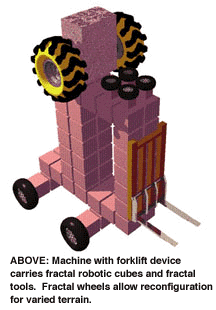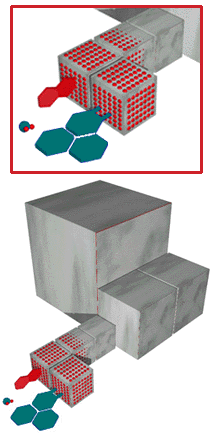
Has science unleashed some uncontrollable mutant, destined to devour our cities and infrastructure? Is this a motion picture? Yes, but a movie run backwards. Seen from the beginning (in forward time), trucks arrive at a hole in the ground dumping structural materials to the side. A few special trucks appear loaded with solid rectangular cargo Suddenly these featureless cargoes become animated, break into individual cubes and "pour" themselves off the flatbeds to the ground by sliding over and around each other. Now a chunky blob, the mass raises itself from legs made of its own cubes, while cubes at the top slide over the bottom cubes, then down the leading edge to.make more legs as back legs withdraw into the mass. The monstrosity "walks" over by two other off loaded blobs. The blobs congeal into a larger mass then heads for a pile of steel I-Beams.
  From inside the creature, stubby arms appear, sliding over the cubes' flat surfaces, heading towards the steel. Great numbers of beams are hoisted from the ground and elevated to the top of the mass as other arms slide down for more. Then, the whole monster morphs and pours down the hole with the beams. From the ground, one by one, beams appear vertically in a symmetrical pattern and other beams are attached crosswise by arms with whining torque wretches. What is going on? What are these things? They are Fractal Shape Shifting Robots. You are witnessing the birth of an age called "Digital Matter," where units of matter are controlled discreetly, like computers treat bits of information.
The New Unlimited Machine
Fractal Robots are programmable machines that can do unlimited tasks in the physical world, the world of matter. Load the right software and the same "machines" can take out the garbage, paint your car, or construct an office building, and later, wash that building's windows.
Fractal Shape Shifting Robots look like "Rubic's Cubes" that can "slide" over each other on command, changing and moving in any overall shape desired for a particular task. A "Tool Kit" of mobile, programmable arms for manipulating beams and construction material as well as welders, cutters, power wrenches etc. can attach themselves where needed on any cube surface. They work in large masses and cubes appear identical to each other. From a distance they may resemble an industrious amoeba as they construct... without traditional human labor, 24 hours a day, in any weather.
These cubes communicate with each other and share power through simple internal induction coils (or surface contacts in some models), have batteries, a small computer and various kinds of internal magnetic and electric inductive motors (depending on size) used to travel over other cubes. Construction cubes are big, but utilize smaller cubes to slide into "tight spots" as needed.
Self sustaining systems and self-assembly of large and smaller cubes is a goal that could drop cost dramatically and enable successive generations of robots exhibiting greater industrial utility. When sufficiently miniaturized (below 0.1mm) and fabricated using photolithography and E-Beam methods, the machines may exceed human manual dexterity and could then be programmed to assemble complex fractal aggregates that maintain the photolithographic and E-Beam equipment needed for smaller generations-- perhaps to the molecular scale... Nanotechnology.
Interestingly, the more cubes in a mass the more computers communicating with each other enabling "smarter" behavior. When not engaged otherwise, a million cubes could be contracted out from any location utilizing the internet, as a very powerful massively parallel supercomputer.
The bricks are like Lego bricks in that
they snap together to make a new shape. The bricks
have interior motors that allows them to slide around
under computer manipulation and create new shapes
similar to the way kids build toy houses or toy
bridges. This gives us 'Digital Control of Matter'. To
make the machine 'fractal', special bricks have half
size plates on one face that allow half size bricks to
join. These in turn can have quarter size plates to
attach quarter size bricks and so on like the
diminishing branches of a tree, until we get to
microscopic bricks. The smaller the bricks, the finer
the control we have over this 'digital matter'. Large
bricks are electromechanical robotic devices, but as
they diminish in size they will be fabricated using
micro-machining and chip manufacturing techniques.
Below 100 microns, they can use electrostatic motors
until we get down to cubes of nano dimensions
where the individual atoms become too big. At these
scales, as our knowledge of surface chemistry
improves, the robotic cubes will be able to interface
directly with molecules opening up new avenues for
exploring the manufacture of nanotechnology
devices.
Presenting, Fractal Shape Shifting Robots, Programmable "Digital Matter"
Michael is head of *Robotic Construction International. Dallas based *Zyvex Corporation was the first nanotechnology company with the specific goal of developing the Molecular Assembler (a device that can build with individual atoms and led to self replicating machinery and consumer goods). Zyvex is taking what is generally known as a "Bottom Up" approach to developing an assembler, building components with atoms and molecules and are some 5 -10 years away from the first "breakthrough."
The advantage of Michael's "Top-Down" approach is that useful products can be developed from existing prototypes in less than two years. Consider Michael's next technology demonstration under development right now: Two large Plexiglas aquariums are set parallel to each other, 24 inches apart (this is an arbitrary number and could be 24 feet). Towards the top of the first aquarium, a hole is drilled and fitted with a tube leading to a hole in the second aquarium. Now both are connected.
On the floor of the first aquarium, several feet from the top-- sits a large group of three inch cubes, arranged in a neat pyramid. Some of the cubes have stubby, electrically powered grippers, held on the cube's featureless surface by internal electromagnets. Surrounding the cubes is a box frame made of model I-Beams that snap together at the ends. This skeletal box of I-beams is representational of construction elements used for assembling a toy train bridge trestle, or the structural members of a skyscraper.
On command, the "pyramid" begins to move over its bottom cubes towards one corner of the box. The overall shape changes as cubes slide over each other, reaching up and snaps the top joint, while cubes at the bottom do likewise. "Gripper" cubes slide with the disassembled beams in tow, and release them on the aquarium floor. The process is continued until all the beams are free.
Then, looking like that chunky amoeba, the mass of cubes change shape dramatically, as they slide over and up each other "crawling" towards the connecting tube above. The mass gets thinner as it gets longer, heading north. The first few cubes reach the opening and the outer line of traveling cubes shift motion 90 degrees and start entering the tube.
After enough cubes have entered the tube to anchor a hoist of the remaining mass, gripper cubes grab individual I-beams and haul them to the top, then rotate the beams to enter the tube head first and disappear. After the last beam, the remaining cubes are hoisted by cubes at the top, and the whole mass disappears from the first aquarium. In the second aquarium, a group appears from the tube descending down the glass in a line to form an elevator for the mass.
Beams appear and rotate, then descend to a forming base of cubes. Once all the cubes are out and down, the mass begins reassembling the box, starting from the ground up. After the box of beams is complete, the cubes retreat to the center and again, form a pyramid.
This process can be repeated until the batteries drain, or indefinitely if supplied with recharging induction coils in the floor of the aquarium.
A structure normally requiring millions of dollars of labor can be
constructed with this equipment, working tirelessly-- 24 hours a day in any weather, attaching beams in parallel to finish a job in a fraction of the normal require time-- then go on to build again. The whole mass can literally "walk" to the next job site. This is Robotic Construction International's first commercial application of Fractal Robotic technology.
Other "large" cube applications include modifying the technology for the installation of masonry or marble facades, windows, wiring, air and plumbing. Emergency aircraft runways could be erected by programming these robotic cubes to arrange themselves in flat masses of plates. If cubes became damaged, they could be automatically discarded and replaced by the other cubes Such temporary airstrips can be carried on ship where they are
"dumped" into the sea, and "walk" themselves to land. Minefield clearing cubes could run about autonomously keeping tack of location with satellite navigation, brimming with sensors sniffing explosives, detecting magnetic fields, using ground penetrating radar and even X-Ray and Gamma-Ray spectrography (bombard the ground and see what bounces back).
Smaller cubes get interesting. A large number of tiny cubes, possessing much computer power could be a great childrens toy, morphing into letters, speaking to and teaching kids to read-- later, picking up the kid's room and, if needed, walking the dog. How long before cubes become tireless indispensable servants?
Like many inventions, all the parts were already "on the shelf"-- it just took someone to put them together. The large 3' heavy construction models (first commercial application) will be a "gentle" introduction to the world of "Digital Matter." These things come with "tool kits" including "stick on" arms to manipulate materials. When cube assembly by other cubes drops price dramatically and the use of older generation chip facilities start pumping out masses of sub-millimeter generations, also assembled by other cubes... things could get interesting. The engineering path is clear.
Remember the "bad guy" robot in Terminator-2... what's the difference?
Techinical graphics and animations created by Bill Spence
*Robotic Construction International:
*Zyvex Corporation:
Development: 
Producer of the first computer animated series on Molecular Nanotechnology for the Discovery Channel of Canada (1996),Bill Spence is a co-founder and on |

 Appearing from seemingly nowhere, huge amorphous blobs congeal on skyscrapers and bridges... eating the structures, ripping them apart beam by beam, from the top down in some bizarre slow motion choreography, stacking the construction materials in neat piles around their consumed victims. Soon, whole buildings are razed to the ground, surrounded by their own components.
Appearing from seemingly nowhere, huge amorphous blobs congeal on skyscrapers and bridges... eating the structures, ripping them apart beam by beam, from the top down in some bizarre slow motion choreography, stacking the construction materials in neat piles around their consumed victims. Soon, whole buildings are razed to the ground, surrounded by their own components. Basic concept of a
fractal robot
Basic concept of a
fractal robot